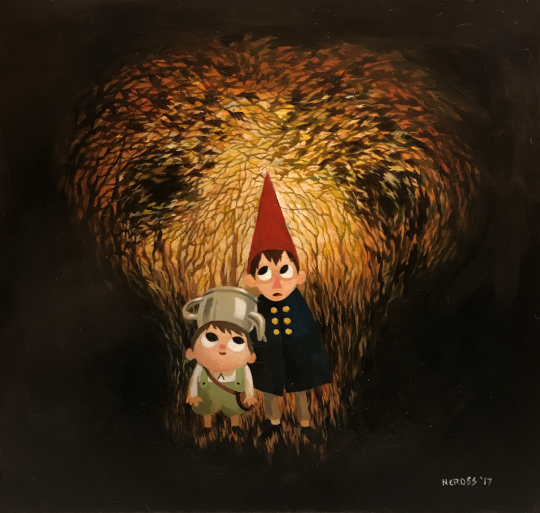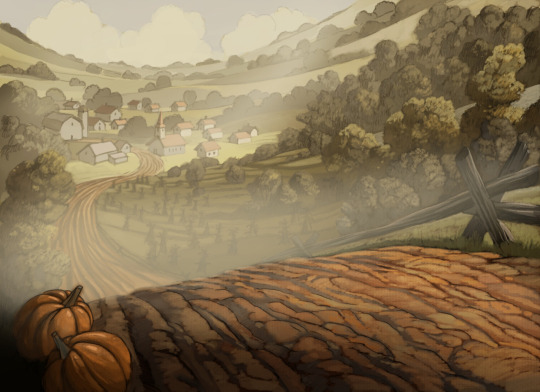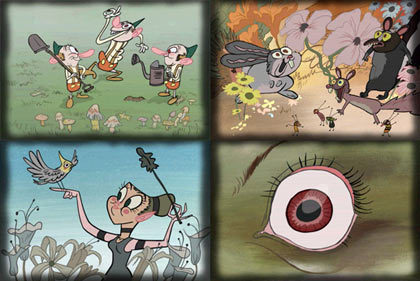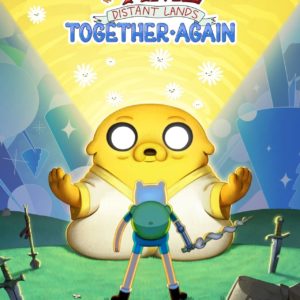Nick Cross is a two time Emmy Award-winning Canadian animator. You may know him best as Art Director of Over the Garden Wall (2014), the Cartoon Network mini-series that demolished long-sniffed presumptions about visual beauty in TV animation. Watching “Yellow Cake” (above) and Nick’s other great films leaves no doubt as to why he was pegged for the job; reading this interview, you’ll see why he was keen on the challenge. Nick weaves elements of old cartoons – whimsy, innocence, and yes, even cutesiness – into cynical social narratives. As Art Director of the Cartoon Network Shorts, many titles he’s worked on are becoming hotly-anticipated new series—I’m as excited for his upcoming short,“The Clockwork Elves,” as I am for them (very).

What inspired “Yellow Cake”?
The Iraq War: when they were trying to justify invading Iraq, “yellow cake uranium” was the phrase repeated. Yellow cake sounds like a delicious treat, but they made it sound so ominous. So I thought, what if it actually was a dessert, being made out as a threat? It’s also a cat and mouse cartoon—so sort of using the language of old cartoons to tell a different kind of story.
Do you set out to make cartoons that deal with class division and war, or do they just go that way in the making?
I think I just get really bummed about current events, and this is how I can put them into a context I can control. Class definitely exists and people, in the West especially, don’t want to admit it. And when we invaded Iraq, it really struck me that this horrible war was going on, and people weren’t bothered. I grew up hearing about WWII and Vietnam; how with rationing and the draft, everyone felt it when the country went to war. And now it’s so easy for people to pretend it isn’t happening. Same as how people get away with viewing global warming as an abstract concept, and ignore the environmental disasters that are ruining lives—just as long as they’re not affected.
Why do you gravitate toward the old cartoon style?
My favorite cartoons are the old Hollywood ones from the 30s and 40s, especially old Warner Bros. And my background is in painting—I love classical art. Someone recently said, “I thought you just liked old paintings?!” and I was like, “Yeah… but I like Bugs Bunny and seeing someone get punched in the face, too.” It’s that mix of low and high brow. Which is part of why the films I make are cartoony with darker themes. It’s just what I like.
Who are your biggest artistic influences?
René Magritte is a huge influence. In high school art class, he was my introduction to surrealism. It blew my mind. He’s been a major influence since. Besides him, there are just too many…. I’m influenced by pretty much everything. Turn of the century and 20th-century art; German expressionism might be my absolute favorite. For like two years all I watched were silent films. And then with Over the Garden Wall, people have actually gone through and identified all of the inspirations. We were just copying stuff and putting it in. Like the old Disney Alice Comedies, with a real girl in a cartoon world, we blatantly pulled from that. We didn’t try to hide the influences.

Before OTGW, you were a background painter on the preceding short, “Tome of the Unknown.” How did that opportunity come about?
An email out of the blue. The art director, Sue Mondt, asked if I was interested and I said, “Sure.” I was doing storyboards at the time and a little background painting seemed like a fun distraction, extra money or whatever. They didn’t send me any visual material and I assumed it was going to be something simple. Then I received the first background design by Chris Tsirgiotis, in pencil and rendered. It looked just like a beautiful old Disney background. I was like, “Oh okay, THIS is what it’s going to be.” I quickly got on the phone with Pat (Mchale, Director) and he told me to, “Just paint it however”. So I went nuts with it. Elaborate stuff like that, you never get to do for TV. It was nice because he trusted me to do it, and yeah… I just went nuts.
You lived in Canada at the time – how’d they find your work?
Later, Pat said he’d always wanted to make something with classical painting backgrounds. Since everyone’s gone digital, that’s kind of dropped away. He saw one of my films online, “The Pig Farmer,” (below) where I had painted backgrounds and thought, “Like that!” So I guess when CN asked who he wanted to work with, he put my name down. I had a lot of fun with it, sent in my work and they were like, “Okay great! You’re done!” I didn’t hear anything for months, until Pat reached out to tell me it’d been picked up as a show, and would I want to art direct it? I was like “Yeah!”
Backing up: where did you go to school, and what did you study?
I went to Sheridan College in Ontario and studied Illustration. It was art training—they skewed it toward commercial art. Like how to illustrate for magazines. That field was already waning in the early 90s. Computers were coming in, all of the teachers were mad about it. I was lucky to get classical training in painting.
Did you ever consider switching to animation in college?
Yeah it’s funny, because Sheridan is known for its animation program. We shared buildings with them and I was always like, “Meh, animation. I could never draw the same thing all the time”. It seemed boring and I envisioned myself as a painter or whatever. But I couldn’t find a job in illustration, dying business and all. I floated around for a few years, then a college friend moved to Ottawa and randomly brought his portfolio to an animation company near his new place. They happened to need artists with illustration training to do background layout, and asked if he knew anyone else for the job, so he called me. It was really a lucky break. Especially since my portfolio was nothing you’d want for animation—it was all painting.
Are backgrounds the best entry for artists without animation training?
Yeah, because you don’t need to know animation to draw trees, buildings, and furniture. You learn fundamentals like perspective and composition on the job. BG layout is mostly shipped overseas now, but there’s still BG painting and design. You learn to set the stage for the characters and how animation works, but you don’t need a ton of training or special skills to be able to do it. Whereas with storyboarding you need film training; character layout you need to know how to turn a character. Backgrounds are the easiest in.
What were your career skipping stones?
Background layout, then character layout, then storyboard clean-up. I worked my way into storyboards; I’d started making my own films, which is how I was able to sort of convince people I could do it. They saw my films and must have figured “Okay, it looks like he knows what he’s doing. A little bit. Just enough.”

What motivated you to start making your own films?
Once I started working in animation, I got really enthusiastic about it as the perfect medium for introverts like me. Because I’ve always loved films, but thinking about making one… you have to hire actors, go out and find locations, it’s this whole ordeal. But with animation, you can just sit and draw it all out. I realized I could make an entire film cheaply and by myself, if I wanted. It’s ideal.
How did you learn to animate, and what programs did you use then and now?
I learned by making films. I also read books, like the Preston Blair book that sets up all the fundamentals. Sometimes animation jobs would come into our office and I’d tackle them, with tips from people who were more experienced. So no formal training, but I wasn’t self-taught in a bubble. This was the late 90s, before animation programs were normal. I would draw on paper, scan it in, color it in Photoshop, then composite it all in Adobe Premiere. It was laborious, editing frame by frame. Most recently, I used ToonBoom Animate, and now I’m starting to use TVPaint.
How do you achieve Disney-esque aesthetics in your films without that budget – how is it possible?
So… it’s not. But. If it’s a short project… you can sort of do it. My own aesthetic is just, I like things to look elaborate. I like to paint and get really involved with the details. There’s no budget or schedule for my own work, so if I spend 3 years making a 5-minute short, it’s no big deal. And then for Over the Garden Wall, because it was a mini-series we could make the 10 11-minute episodes more elaborate. I also just did a lot of the work myself, because it was tough to find people who could, and it was asking a lot of artists and the overseas studio. So we hoarded a lot of work to make it easier on everyone. There’s a reason shows don’t usually look like that—it’s asking too much of everybody on a TV budget, which really isn’t that much money.
Was having more elaborate art a factor in making OTGW a mini-series instead of full?
No, that was mainly that Pat didn’t want to stay in LA, and you have to be in LA to run a full series. So Cartoon Network offered a mini-series instead. It was really nice: they wanted to do it, so they were willing to try something different and take a risk. None of us actually knew how to make a mini-series. It was like making a feature in chapters. We figured it out as we went along, which was weird because CN just… let us do it? It felt like we were getting away with something. Personally, I was excited to make something that hadn’t been done on TV before. It felt like proving a point.

(stills from “The Waif of Persephone”)
Was proving a point a motivation for you, going into OTGW?
Yeah. I think a lot of the stuff I try to do is because I was told I couldn’t. Part of why I’ve gotten so elaborate in my own films is someone a long time ago said that no one would ever be able to make something as beautiful as Pinocchio again. I was like, “Oh yeah?! We’ll see about that.” I haven’t quite achieved it yet… but it’s that thing of someone setting restrictions, and it just makes you want to break them. I mean, even my big impetus to teach myself animation was when I first learned about using exposure sheets – they break actions down frame by frame – and I was like, “Cool, I want to learn to do that!” And someone was like, “Oh, no no. You can’t. You’d need to go to school for animation. No, no.” And again, I thought, ‘Yeah… we’ll see.’ Don’t tell me not to do something, because I will try to do it.
Is that how you started making a feature (Black Sunrise) on your own?
With that, someone probably said I could do it. I bit off too much, especially now that I work full time in the shorts department at Cartoon Network—I just don’t have the time. Which stinks, because I hate to leave it unfinished, and people are still asking me, “Where’s the movie, when’s the movie coming out?” Eerrgh. I’m almost finished with a short though, called “The Clockwork Elves”.
Cool! Can you say what it’s about?
I really can’t. I’d spend like a half hour just rambling ideas. I’m not a good pitcher or salesman – I’ve never been able to just be like, “Here’s the log line! Ba dum bam!” I also usually don’t know what my films are about until they’re done. I just start drawing and let the idea form, if it does. They’re like clouds; sometimes they take shape, sometimes they just dissipate.
One of my favorite moments in OTGW is the Highwayman’s song and crazy dance. How did THAT idea come to be?
Pen and Pat came up with this character idea of the Highwayman, and Pen did the board and wrote the song. I think we were pitching ideas – I have this thing where I like to offer stupid ideas – and I said we should have him dance around like in an old Fleischer cartoon. They’d use rotoscoping, tracing over live action actors, so in Koko the Clown and Betty Boop cartoons, there’d be these absurd dance sequences. A sort-of crudely animated character would be moving really smoothly—it didn’t look right. It always stood out like it didn’t fit. So I said we should have him dance around all weird, and instead of ignoring my dumb idea Pat was actually like, “Yeah, yeah let’s do it!” so we moved ahead with it.
And we were talking about having it animated in Korea and needing it to look rotoscoped and maybe it being too much to ask… so I ended up volunteering to animate it. From my perspective, I wanted it to be the right kind of weird – just weird enough for people to be like, “Whoa, what? Why is it moving like that?” It was meant to reflect Wirt’s perspective: he’s in this strange inn and all of a sudden this guy is dancing in a weird way, and it’s just off-putting. So that was the idea. And again, it’s nice because… no one ever questioned it!? I’m so used to everything needing all these levels of approval. And this was just me and Pat deciding we wanted to do it and putting it in. It really felt like we were being paid to make our own project.
Follow Nick at: @ncrossanimation
Thank you for the interview Nick! I can’t wait for “The Clockwork Elves” to come out.
– Cooper



